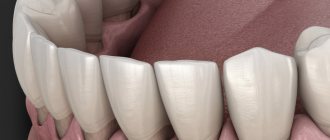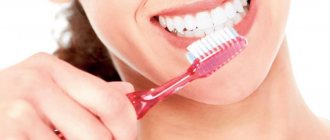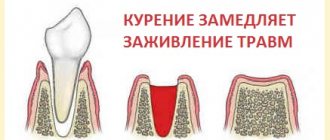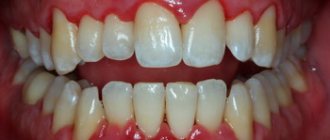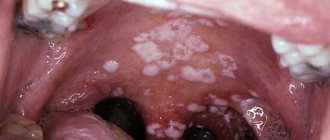Tartar is a common problem, but no less acute. Unaesthetic plaque on teeth not only spoils a beautiful smile, but also contributes to the development of more serious dental problems - periodontitis, gingivitis and caries. Is it possible to get rid of tartar on your own? - No. Only professional cleaning performed by a dentist in several stages will help. It will be useful for patients who are afraid of any dental procedures to learn how tartar removal occurs, how long this procedure lasts, how painful it is and what effect to expect after.
What does tartar look like?
Tartar is a mineralized, dark-colored plaque on teeth. It is deposited mainly on the back side of the front teeth and in hard-to-reach interdental spaces; it consists of dead cells, bacteria and salts.
There is a misconception that tartar itself is not noticeable and not scary, and its presence does not in any way affect the health of the teeth. This misconception makes people not notice the growing plaque for years until the gums become inflamed in the affected area or a carious cavity forms. It is important to understand that tartar poses a serious danger to human health; it must be diagnosed promptly and disposed of immediately.
Consequences
Many people do not consider the formation of tartar to be a problem and are in no hurry to see a dentist. If plaque has formed on the inner surface of the teeth, it is invisible during communication, and the person mistakenly believes that the problem does not exist. In fact, the appearance of stone is quite dangerous for the health of teeth and gums. Let's start with the fact that its location at the very edge of the gum can cause gum bleeding over time and contribute to the formation of a periodontal pocket in which food debris will accumulate, causing inflammatory processes in the gum.
If the stone is not removed in time, the consequences can be dire, including loss of teeth. After all, dental plaque is an excellent environment for the proliferation of pathogenic bacteria, in particular those that cause caries.
We must remember that the process of formation of tartar is long, so a systematic visit to the dentist will help get rid of the cause in a timely manner, avoiding complications. It is useful to carry out professional hygiene procedures at least 2-3 times a year, including the removal of dental plaque. This will help avoid such unpleasant consequences as bad breath, caries and inflammatory gum diseases.
How is tartar formed?
Stone formation begins when plaque remains on the teeth after eating. At first soft and friable, in the absence of proper oral hygiene, it gradually reacts with the components of saliva, oxidizes and hardens. Over time, layers of plaque mineralize and tartar forms.
Plaque, which eventually turns into tartar, comes in two types:
- Subgingival
Plaque that can form on any tooth, regardless of its location. You won’t be able to detect it yourself; this can only be done by a doctor using a probe or gum recession.
- Supragingival
This plaque usually forms on the teeth closest to the salivary glands and has a yellowish or gray-brown tint. You can detect it in the oral cavity yourself, but it can only be removed with the help of a dentist.
Increased tooth sensitivity after professional cleaning
After professional teeth cleaning, especially after cleaning the subgingival area, teeth may become overly sensitive for a while. Gradually this feeling will disappear and your teeth and gums will be healthier than before. If the increased sensitivity of teeth that occurs after professional oral hygiene persists longer than usual, the dentist will provide you with the necessary assistance and give recommendations.
Professional teeth cleaning
The only way to get rid of calcified plaque, that is, tartar, is to have your teeth professionally cleaned at your dentist's office. Tartar most often forms on the surface of teeth along the gum line or below the gum line, as well as in other areas that are difficult to reach with a toothbrush. The dentist or hygienist removes it using special instruments, scalers. This procedure is called scaling. The hygienist can also perform root smoothing - remove plaque and tartar from the top of the tooth roots by inserting an instrument between the tooth and the gum.
Before such treatment, the gums may be inflamed and swollen. Sometimes deep gaps, so-called periodontal pockets, even form between the gum and tooth, in which bacteria accumulate. Removing dental plaque and smoothing the root surface allows you to get rid of these problems, but the procedure itself can cause discomfort and bleeding gums. If the dentist has reason to believe that the cleaning process will be particularly unpleasant for the patient, he may use local anesthesia.
What happens next
General soreness, increased tooth sensitivity and bleeding gums are normal reactions of oral tissues to professional teeth cleaning. Some of these reactions are caused by the contact of instruments with inflamed gums that easily begin to bleed. Other reactions are due to the fact that as a result of this procedure, those areas of the teeth that were previously covered with plaque or tartar are exposed. Where gum recession occurs, scaling exposes the neck or root of the tooth, and it takes time for the teeth to adapt to the new condition. Since the neck and root are not protected by strong enamel, they are more sensitive than the crown of the tooth.
Sensitive teeth
Dentists believe that normally, bleeding, discomfort and increased sensitivity of teeth after professional oral hygiene can last no longer than a week. With careful and regular oral hygiene, swelling, hypersensitivity and bleeding of the gums gradually decrease, but the feeling of general discomfort in most patients disappears in one or two days. As for increased tooth sensitivity, in everyday life - especially when drinking hot drinks and cold food, chewing food and brushing teeth - it is quite difficult to avoid unpleasant sensations, but after a week they should stop bothering you.
Caring for your teeth after professional cleaning
Careful dental care following professional oral hygiene helps gums heal by reducing exposure to irritants that cause pain and sensitivity. Stop flossing for at least a day; While your gums are still sore, gently brush your teeth using a soft-bristled brush and a special toothpaste for sensitive teeth. Avoid foods and drinks that cause discomfort. If tooth sensitivity persists for more than a week after professional cleaning, or if other problems arise, make a follow-up appointment with your dentist, who will check how well your gums are healing and possibly apply a special professional solution to sensitive areas of your teeth.
Teeth hypersensitivity after professional cleaning is not a problem that requires immediate medical intervention: you can cope with it yourself by using a special toothpaste and watching your diet. If symptoms persist for more than a week, contact your dentist, but remember that discomfort may also be caused by mistakes you made during oral care.
The main reasons for the formation of tartar:
- Insufficient oral hygiene.
This also includes using the wrong toothbrushes. A brush that is too hard can regularly injure the enamel, increasing the sensitivity and vulnerability of teeth, while a brush that is too soft does not completely clean out even soft plaque, which results in the proliferation of bacteria in the mouth, caries and tartar.
- Poor nutrition.
Eating large amounts of fatty and sweet foods, the remains of which form a nutrient medium in the oral cavity for the growth and reproduction of microorganisms.
- Smoking.
The adhesive substances of nicotine resins are deposited on the tooth enamel in the form of a yellow film. Over time, this film, to which soft plaque adheres, mineralizes and turns into tartar.
- Chronic diseases of the digestive system and metabolic disorders are also provocateurs for the development of caries and tartar due to an imbalance in the acid-base balance in the mouth.
Hardened plaque has a mineral-salt composition, so it is impossible to deal with it yourself at home. Removing tartar in modern dentistry is a procedure that is as simple and painless as possible.
Kinds
There are two types of tartar, depending on its location - subgingival and supragingival.
Subgingival tartar can only be detected by a dentist using a special probe, since it is hidden from view by the edge of the gum. It is located in the periodontal pocket and fits tightly to the root. The color of this stone is usually dark brown or greenish-black, it is extremely hard and consists mainly of calcium phosphate, magnesium phosphate and calcium carbonate. If subgingival stone is not removed in a timely manner, it can provoke an inflammatory process in the periodontium and cause periodontitis.
Supragingival tartar can be diagnosed independently; it stands out on the surface of the enamel with its yellowish or brownish color and is easily removed using a dental excavator. It is usually located above the crest of the gingival margin, so it is easy to recognize. In terms of density, supragingival stone is much softer than subgingival stone, since it is a salivary type formation and consists mainly of epithelial cells, bacteria, mucus and food debris. If it is not removed in a timely manner, over time the hardened plaque turns into caries.
How to remove tartar
If tartar has already formed, you should not try to remove it yourself; any unprofessional mechanical impact can lead to damage to the enamel and infection of the gums. In most cases, it takes about an hour for a professional dentist to remove the stone. The algorithm is as follows: first, the doctor carries out a total cleaning of the teeth, then proceeds to remove supragingival calculus; if there is a subgingival one, the doctor carefully releases the neck of the tooth and then removes the stone that has formed there.
The dentist’s task is to rid the patient of tartar and restore his dental health. Depending on the technical equipment of the dental clinic and the patient’s health characteristics, dentists solve this problem using the following methods:
Do your teeth hurt after brushing? Let's figure it out!
A snow-white smile and beautiful, straight teeth these days have become not just very popular, but also an extremely necessary feature of appearance, on which the quality of a person’s social communication, his professional career, and success in his personal life depend. Nowadays, many people use the services of specialists working in the field of aesthetic dentistry and regularly undergo professional dental cleaning. But not everyone is aware of the intricacies and features of such a procedure, so they wonder why their teeth hurt after brushing , for example, with the advertised safe ultrasound?
Learn more about the benefits of teeth whitening and teeth cleaning
Mechanical stone removal
Mechanical method
Initially, tartar was removed only mechanically - using a special metal hook, which was used to separate the stone from the tooth. The procedure was quite painful and traumatic, so in recent years this method has not been popular; it has been replaced by more effective and much less traumatic ones.
Ultrasound removal
Ultrasound removal
Ultrasound technology has become widespread in modern dentistry, through which tartar removal is carried out as efficiently and painlessly as possible. The technology does not involve contact of the device with the surface of the tooth; enamel cleansing occurs due to directed ultrasonic waves of a certain frequency. The procedure is painless, however, if there is high sensitivity or at the request of the patient, the doctor can use an anesthetic gel.
Despite the popularity of the ultrasound method, it also has some disadvantages:
- an inexperienced dentist can make a number of mistakes that can lead to damage to the gums and enamel;
- increased sensitivity and severe demineralization of teeth can cause pain during and after the procedure;
- the ultrasonic method cannot always be used to remove subgingival stone;
- The ultrasound method is not suitable for patients with a large number of old fillings due to the risk of them falling out.
There are also restrictions on the use of ultrasound for patients with cardiovascular diseases and installed pacemakers. Before the procedure, the doctor will definitely ask the patient about possible contraindications and, if necessary, recommend another method.
In what cases is pain after canal cleaning not normal and what to do?
If the pain does not subside within several days and does not decrease, this may indicate complications or that the treatment was carried out incorrectly.
When pain is a symptom of pathology:
- if the pain does not decrease within several days;
- if the pain increases;
- for acute and throbbing pain;
- swelling and severe swelling of the gums;
- increased body temperature;
- general deterioration of health.
In these cases, you should immediately consult a doctor; there are complications after treatment.
Abnormal pain can result from a number of factors:
- a mistake made during treatment;
- poor-quality cleaning of the canal - repeated opening and cleaning is required;
- a fragment of a tooth or instrument remains in the canal cavity;
- individual intolerance of the body, allergy to components in the filling material or medications;
- poor-quality placement of the filling or the filling material protrudes above the surface of the tooth;
- inflammation of periodontal tissue – the infection has spread from the pulp to the gum;
- perforation of the canal walls due to accidental movement of the instrument;
- during the treatment the tooth root was touched and damaged;
- penetration of infection and development of re-inflammation.
In all these cases, inspection, diagnosis, identification of the problem and its prompt elimination are required.
If you ignore the symptoms for a long time and postpone a visit to the dentist, this can increase the inflammatory process and ultimately lead to the need for tooth extraction. Moreover, an infection that is not eliminated in time can spread to neighboring teeth, causing inflammation and the development of the disease.
In no case should you try to fix the problem yourself, much less apply heat compresses to the affected area, take hot food or alcohol - this stimulates the development of inflammatory processes and suppuration. The only solution to the problem is an immediate visit to the clinic.
Laser removal
Laser removal
An effective and painless method of removing tartar is laser exposure. The laser teeth cleaning procedure is very popular; it allows you to remove stone and restore the natural shine of the enamel. Laser exposure strengthens tooth enamel and makes it more resistant to external influences; such cleaning reduces the likelihood of developing caries or gingivitis. Often, the doctor recommends preventive laser cleaning before planned treatment in order to detect caries in the early stages.
Compared to other methods, laser stone removal has a number of advantages:
- Maximum efficiency. The result is noticeable immediately after cleaning and has a prolonged effect.
- Safety for tooth enamel and gums. Laser cleaning does not injure either tooth enamel or gums. Moreover, laser exposure has a bactericidal effect and helps eliminate inflammation.
- Teeth whitening effect. After removing tartar with a laser, patients note that the color of the tooth enamel has become several shades lighter.
Despite its high popularity, this method of removing tartar also has its contraindications:
- the patient's age is less than 18 years,
- the presence of periodontitis,
- presence of braces,
- a large number of fillings and artificial teeth,
- the presence of endoprostheses,
- heart and vascular diseases,
- bronchial asthma in the acute stage,
- any infectious and viral diseases (herpes),
- increased sensitivity of teeth,
- HIV, tuberculosis, hepatitis,
- pregnancy and lactation period.
If no contraindications are identified, then laser tartar removal is carried out as follows:
- To begin with, the dentist removes all soft plaque mechanically. For this purpose, he can use the Air-Flow system.
- Using a special pad, the doctor isolates the gums and mucous membranes from the direct impact of the laser - to protect the soft tissues from possible burns.
- Within 10-20 minutes, the doctor illuminates the patient’s teeth with a laser. During this time, tartar is destroyed and hard plaque flakes off.
- Fragments of destroyed plaque are removed using the Air-Flow system, the enamel is polished, the insulating lining is removed and the tartar removal procedure is considered complete.
At the final stage of laser cleaning, the doctor can treat the teeth with a special fluoride-containing gel in order to further strengthen the tooth enamel.
Why does it hurt to brush healthy teeth if you have hypersensitivity?
Sometimes a dental examination does not reveal caries, pulpitis, periodontitis and other diseases. But the pain during cleaning remains. In this case, most likely, we are talking about increased sensitivity of the teeth.
According to statistics, more than 50% of the population have increased tooth sensitivity. This is the name for a condition in which dentin, a porous layer located under the enamel, is exposed. It contains tubules - microchannels leading to nerve endings. When the dentin tubules are exposed, the nerves become vulnerable to any irritants, the tooth reacts with acute pain to cleaning, touching hot and cold food. Dental hypersensitivity can occur for several reasons:
- eating sour or sweet foods,
- too much pressure when cleaning or incorrect selection of bristles stiffness;
- habit of grinding teeth;
- professional teeth cleaning, whitening.
These reasons can cause thinning of the enamel, promote the growth of bacteria and have a destructive effect on the gums, resulting in increased tooth sensitivity.
This condition causes serious discomfort to a person and prevents them from living a normal life. Ordinary everyday activities - eating, brushing and rinsing teeth, exposure to cold air - cause pain and distract attention from other activities. People with this problem find it difficult to concentrate on work or school, because the slightest reason can trigger another attack of pain.
What is Air Flow
The Air-Flow method can be classified as a mechanical method of brushing teeth. This cleaning is very simple: a water-abrasive solution is supplied into the oral cavity under pressure, which “breaks” and removes hardened plaque in places that are inaccessible to other methods (between the teeth and on the gums). Using the same method, the dentist carefully polishes the enamel, which allows it to be lightened by several tones. For extensive tartar damage to teeth, this method is used as a complement to laser or ultrasonic cleaning.




